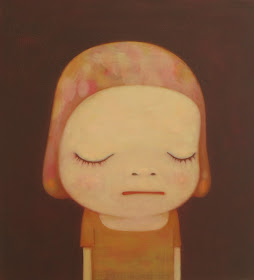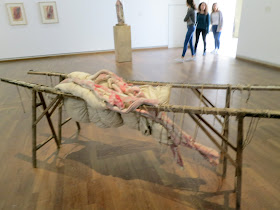Using the body as a starting point,
I address universal themes.
In this way, the body in my work
refers to humankind in general.
Berlinde de Bruyckere.
Suture, by Berlinde De Bruycere, at the Leopold Museum, Vienna.
Ever since we saw the exhibition of Berlinde De Bruyckere's work in London (which you can see
here ) I have wanted to see more so I was extremely pleased to find that there was an exhibition of her work in Vienna. It did not disappoint.
The exhibition catalogue tells us that:
'With her seemingly timeless figures, De Bruyckere addresses existential questions of life and death, pain and suffering but also of love and compassion, and emphasizes how human existence is anchored in the flesh. The fragmented bodies of her waxen sculptures, which at times exhibit an uncanny realism, appear charged with historic, cultural and iconographic references. Looking at De Bruyckere's work we are made aware of ideas and emotions issuing from the traces of our own memories and fears as well as from the contents of our collective memory.
This exhibition has been based around the concept of the suture as a metaphor for the artist's sculptural thinking. In terms of her motifs, the frequently appearing seams show the 'stitching up' of individual realistic or amorphous body fragments to form a new artificial and abstract whole which is so characteristic of her oeuvre. In the figurative sense, the suture is symbolic of the artist's desire to 'tie together' the raw physical appearance of the body with thought levels in order to depict mental states via the corporality of the sculptures. Finally, the suture also implies the aspect of connectedness central to her oeuvre - whether it be the interconnectedness of human beings or the connection they have with the world'.
The Wound III, 2011-2012 (wax, epoxy, bankets, iron, leather, horsehair, cloth)
'The wound is a sign of being... Through the wound our insides become visible to the extermal world, which represents a fundamental existential experience', de Bruyckere says about her 2011 series
The Wound, which is testament to the artist's increasing interest in depicting inner, organic structures.
Met Here Huid VI, 2014 (wax, leather wood, iron cloth, blankets, ropes, epoxy)
looking closer
Inside Me II, 2011-2012, (wax, epoxy, wood, cloth, rope, iron)
Inside Me II confronts us with waxen formations reminiscent of entrails. Loosely fastened onto a framework, the interior is virtually pulled over the exterior in this work. The ambiguous title of the work reveals that the artist seeks not only to visualise the organic inner life of the body but also to articulate internal emotions This corresponds to De Bruyckere's general handling of the organic body, which she perceives and utilises as a means of expressing inner feelings.
The entrails-like structures encountered in the work can also be read as the branches of a tree. The focus is thus placed on the human body and its surface not only as a sensitive, permeable membrane between the exterior and interior - the aim is also to achieve a synthesis between the organic and emotional inner life of the body, its surface and its surroundings.
looking closer
Invisible Beauty, 2011, (wax, epoxy, wood, iron, leather, wool, rope, horsehair)
a different view
looking closer
Invisible Love, 2011, (wax, wood, iron, leather, rope, horsehair, cloth, epoxy)
looking closer
looking closer
Les Deux, 2011, (horse skin, polyester, trestles)
De Bruyckere takes her exploration of suffering to animals as well, showing how vulnerability and fragility are neither individual nor specifically human, but are closely related to life itself. With the purposeful blurring of borders, De Bruyckere takes her exploration of suffering not only to a more general level but also expresses her desire to emphasise mutual connectedness. 'We are all flesh', according to the artist, who with her works seeks to refer to an original sensitivity that humans share with all other living beings.
Into One-Another V to P.P.P., 2011 (wax, wood, glass, fibers, iron, epoxy)
Although De Bruyckere's works primarily reflect pain and suffering as fundamental certainties of humankind, the artist stresses that she places the same emphasis on life as she does on death. The polarity of life and death represents one of the ambiguities that characterise the artist's oeuvre, particularly in those works that address the theme of mutual connectedness.
looking closer
Een (One), 2003-2004, (wax, wood, glass, iron, epoxy)
Een (One), 2003-2004, (wax, wood, glass, iron, epoxy)
a different view
 Pieta, 2007-2008, (wax, cushions, wood, iron, epoxy)
Pieta, 2007-2008, (wax, cushions, wood, iron, epoxy)
The outstretched body evokes the image of Christ taken down from the cross, while Mary's loving embrace is hinted at by means of the cushions on which the sculpture is gently lain to rest. Drawing on pictorial forms from society's cultural images; from the canon of art history; and from the wealth of motifs found in Christian iconography, and the culture of pain reflected in it, De Bruyckere gives expression to human experiences that are valid throughout time - such as the vulnerability of human beings manifested in suffering and pain.
looking closer
San S. 2003-2004, (wax, wood, epoxy, iron)
St Sebastian? The pictorial language could also evoke the image of Christ crucified.
The Muffled Cry of the Unrealisable Desire, 2009-2010 (wax wood, glass, epoxy, iron)
Aaneen-genaaid, 2002 (blankets, wax, jesmonite, wood)
Aaneen-genaaid, means sewn together or sewn to make a whole. In this series De Bruyckere uses waxen fragments of human bodies enveloped by blankets - the question of whether these blankets, which only allow us to imagine the physiognomy underneath them, serve a protective or rather an oppressive purpose is intentionally left open.
The suture as a central motif of De Bruyckere's oeuvre thus not only refers to the artist's method of 'sewing together' individual body fragments with different materials but also serves to emphasise the vulnerability of human beings as one of the most important themes of her work Through her art De Bruyckere addresses general questions of human existence and our existentiality expressed in emotions such as grief, suffering, pain and fear.
Wezen, 2003-2004 (wax, blankets, wood, iron, epoxy)
Glass Dome with Cripplewood II, 2013 (wax, wood, cloth, glass, polyester, epoxy)
* * *
Much later when we visited the Wilhelm Lehmbruck exhibition, still at the Leopold Museum, we came across two more sculptures by De Bruyckere, and some work by Egon Schiele - a bringing together of the three exhibitions that were staged during that time. This is how the curators explained this:
'From Antiquity to Classicism, depictions of harmonious and unscathed bodies were upheld as ideals. But with the arrival of Modernism in the late 19th and early 20th century, artists radically broke with this concept of completeness and introduced the fragmented body, as examples by Rodin, Archipenko, Brancusi and Lehmbruck illustrate. What is confusing about these bodily fragments is the ambivalence of presence and absence, of wholeness and brokenness, of life and death. The fragmentation does not only have a destructive element to it but also refers to the vulnerability and thus the finite nature of human life. Finally, these body fragments may also signal the instability of identity in need of constant reassurance, as illustrated by Lehmbruck's expressive sculpture Head of a Thinker.
This reduction of the body to a fragment is also a characteristic of the works of Egon Schiele and Berlinde de Bruyckere, albeit with different connotations both formally and in terms of content. In his exploration of existential conditions Egon Schiele often dispensed with depicting the body in its entirety... The Belgian artist Berlinde De Bruyckere also addresses fundamental questions of human existence. With her fragmented, often headless sculptures she does not seek to depict individuality or identity, but rather the mystery of the human body and its exposure to constant danger and vulnerability'.

Pieta, 2008, (wax, wood, epoxy, metal)
The curators again:
'Like the oeuvre of Wilhelm Lehmruck, the sculptures of Berlinde De Bruyckere also address existential themes of human existence. In her quest to depict timeless human experiences, the artist dispenses with identity-evoking bodily features such as hands and heads, and draws on pictorial forms handed down from art history - in this case the motif of the Pieta. Contrary to classical Pieta depictions, De Bruyckere does not focus on Christ's body but rather on Mary's embrace symbolised by the crossed-over legs of the two huddled figures. This compassionate gesture serves to highlight the vulnerability of human beings as a central theme of this sculpture'.
looking closer
Hanne, 2003, (wax, horsehair, wood, iron, epoxy, resin)
looking closer
and a different view.







































































